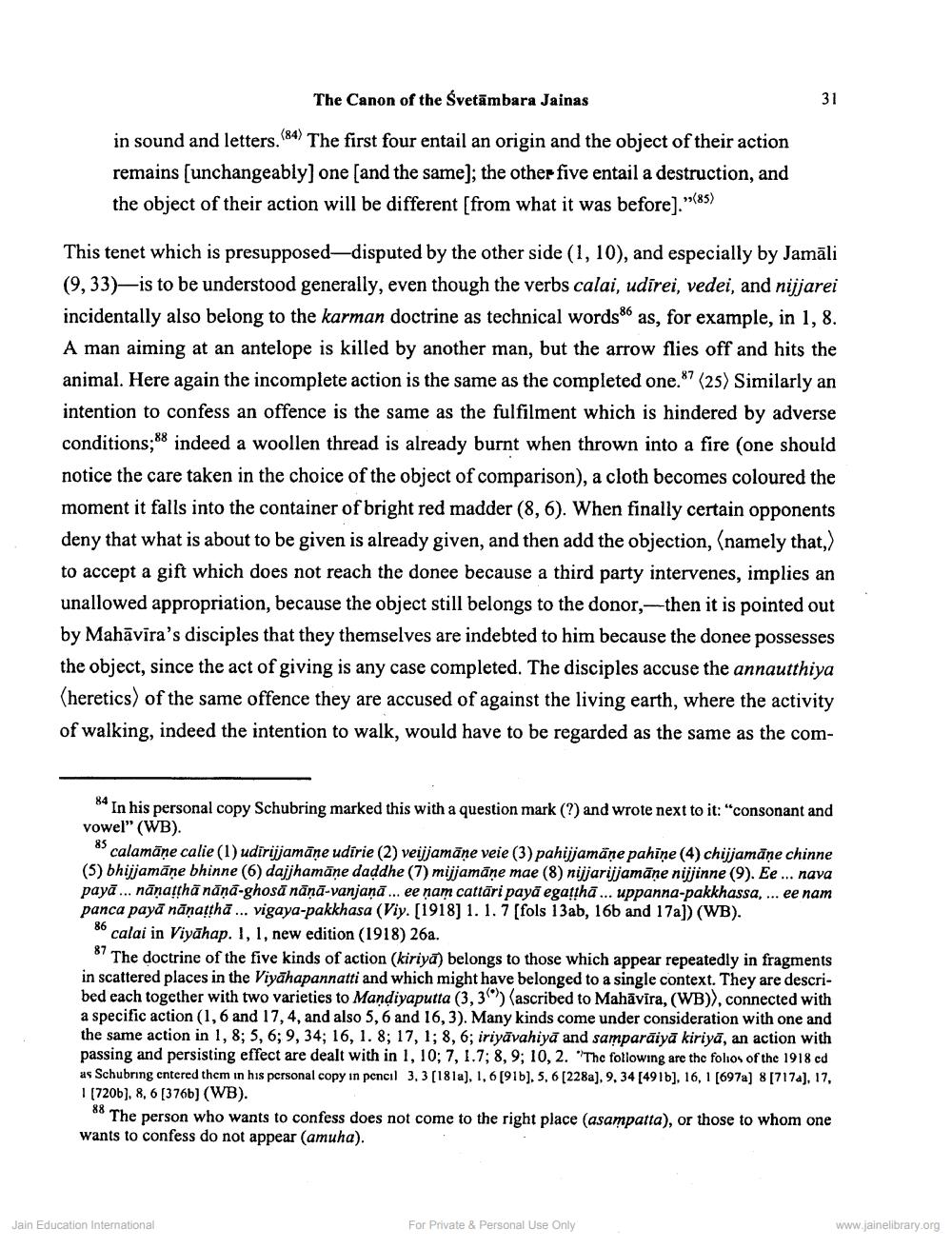________________
The Canon of the Svetāmbara Jainas
in sound and letters. 84) The first four entail an origin and the object of their action remains (unchangeably) one [and the same]; the other five entail a destruction, and the object of their action will be different from what it was before)."(85)
This tenet which is presupposed-disputed by the other side (1, 10), and especially by Jamāli (9,33)—is to be understood generally, even though the verbs calai, udirei, vedei, and nijjarei incidentally also belong to the karman doctrine as technical words86 as, for example, in 1, 8. A man aiming at an antelope is killed by another man, but the arrow flies off and hits the animal. Here again the incomplete action is the same as the completed one. 87 (25) Similarly an intention to confess an offence is the same as the fulfilment which is hindered by adverse conditions;88 indeed a woollen thread is already burnt when thrown into a fire (one should notice the care taken in the choice of the object of comparison), a cloth becomes coloured the moment it falls into the container of bright red madder (8,6). When finally certain opponents deny that what is about to be given is already given, and then add the objection, (namely that, to accept a gift which does not reach the donee because a third party intervenes, implies an unallowed appropriation, because the object still belongs to the donor,--then it is pointed out by Mahāvīra's disciples that they themselves are indebted to him because the donee possesses the object, since the act of giving is any case completed. The disciples accuse the annautthiya (heretics) of the same offence they are accused of against the living earth, where the activity of walking, indeed the intention to walk, would have to be regarded as the same as the com
* In his personal copy Schubring marked this with a question mark (?) and wrote next to it: "consonant and vowel" (WB).
** calamāņe calie (1) udiriijamāne udirie (2) veijjamāne veie (3) pahijjamane pahīņe (4) chijjamāne chinne (5) bhijjamāne bhinne (6) dajjhamāne daddhe (7) mijjamāne mae (8) nijjarijjamāne nijjinne (9). Ee ... nava payā... nāņatthā nāņā-ghosā nāņā-vanjaņā... ee nam cattāri payā egathā ... uppanna-pakkhassa, ... ee nam panca payā nāņatthā ... vigaya-pakkhasa (Viy. [1918] 1. 1. 7 (fols 13ab, 166 and 17a) (WB).
36 calai in Viyāhap. 1, 1, new edition (1918) 26a. $ The doctrine of the five kinds of action (kiriya) belongs to those which appear repeatedly in fragments in scattered places in the Viyāhapannatti and which might have belonged to a single context. They are described each together with two varieties to Mandiyaputta (3, 3)) (ascribed to Mahāvīra,(WB)), connected with a specific action (1,6 and 17, 4, and also 5, 6 and 16,3). Many kinds come under consideration with one and the same action in 1, 8, 5, 6; 9, 34; 16, 1. 8; 17, 1; 8,6; iriyavahiya and samparāiyā kiriya, an action with passing and persisting effect are dealt with in 1, 10, 7, 1.7, 8, 9, 10, 2. "The following are the folios of the 1918 cd as Schubring entered them in his personal copy in pencil 3,3 [181a), 1,6 [91b). 5, 6 (228a], 9, 34 [491b], 16, 1 [697a) 8 (717a), 17, 1 [720b), 8, 6 (376b)(WB).
The person who wants to confess does not come to the right place (asampatta), or those to whom one wants to confess do not appear (amuha).
Jain Education International
For Private & Personal Use Only
www.jainelibrary.org




